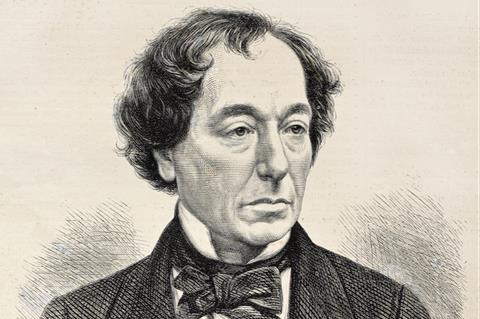“Really delightful”: In a series of archive pieces celebrating the 180th anniversary of Building Design’s sister publication Building, we give you the magazine’s reaction to the 19th century prime minister’s idea to publically execute architects who design boring buildings


Building Design’s sister publication Building is running a series of archive articles to celebrate its 180th anniversary. The first was an account of the construction of the Houses of Parliament. The second, published last week, was Building’s reaction to a proposal by eminent 19th century prime minister Benjamin Disraeli to publically hang architects for designing boring buildings.
Trigger warning: it does not hold back. “This recipe for good architecture is really delightful,” says the editorial. “What can be simpler or more likely to do good execution?”
This tongue-in-cheek response to Disraeli’s idea, presumably also tongue-in-cheek, does contain a serious point. “We would, in a small voice, bid our legislators inquire, if there be no unfavourable influences to which architects are sometimes subject; if they are never trammelled by legislative enactments, over-ruled by employers, harassed by committees, or cramped for want of money?” it says.
This is a regrettable reality of the industry that is still relevant today. Unfortunately for architects, the compromise put forward is for them to be joined on the scaffold by other “delinquents” responsible for the offending designs. Ironically, the buildings mentioned are what are now being held up as paragons of excellence in urban design: the Victorian terraces of St Pancras, Baker Street and Marylebone.
Editorial in The Builder, 3 April, 1847
Dipping into Mr. D’Israeli’s new novel the other day, hight “Tancred,” we stumbled over a proposition, by the author, for improving architecture in Britain’s happy land, which is at once so novel, so startling, and so reasonable, that we should do wrong if we did not bring it prominently before our readers.
He is discoursing upon London, and right pleasantly he does it: he points to its vastness as its most striking point, and says it is the illimitable feeling that gives it a special character. But he complains that, after all, London is not grand. “It possesses only one of the qualifications of a grand city- size; it wants the equally important one- beauty. It is the union of these two qualities that produced the grand cities - the Romes, the Babylons, the hundred portals of the Pharaohs - multitudes and magnificence - the millions influenced by art. Grand cities are unknown since the beautiful has ceased to be the principle of invention. Paris, of modern capitals, has aspired to this character; but if Paris be a beautiful city, it certainly is not a grand one. Its population is too limited, and, from the nature of their dwellings, they cover a comparatively small space. Constantinople is picturesque. Nature has furnished a sublime site, but it has little architectural splendour, and you reach the environs with a fatal facility.”
And then he comes back to the acknowledgment, that London overpowers us with its vastness! Place a forum or an acropolis in its centre, continues our author, and the effect of the metropolitan mass, which now has neither head nor heart (what has become of St. Paul’s?) instead of being stupifying, would be ennobling. “Nothing more completely represents a nation than a public building. A member of Parliament only represents at the most the united constituencies; but the palace of the Sovereign, a national gallery, or a museum baptised with the name of the country - these are monuments to which all should be able to look up with pride, and which should exercise an elevating influence upon the spirit of the humblest. [Most true.] What is their influence in London? Let us not criticise what all condemn.

“But how remedy the evil? What is wanted in architecture, as in so many things, is - a man. Shall we find a refuge in a committee of taste?- escape from the mediocrity of one to the mediocrity of many? We only multiply our feebleness and aggravate our deficiencies. [True again.]
But one suggestion might be made. [Now it’s coming. Prepare for it, good reader, and don’t be alarmed.] No profession in England has done its duty until it has furnished its victim. The pure administration of justice dates from the deposition of Macclesfield. Even our boasted navy never achieved a great victory until we shot an admiral. Suppose an architect were hanged! Terror has its inspiration, as well as competition!”
Well done Young England. This recipe for good architecture is really delightful. HANG AN ARCHITECT? What can be simpler or more likely to do good execution? There are several who deserve it, or at all events ought to be suspended, which sounds like the same thing. This would indeed be breaking the neck of the difficulty, and elevating the profession in right earnest. Mr. D’Israeli evidently observes how architects are being shouldered on either side, and thinks it high time that they were set up in a new line. They have been run down long enough: now, he says, they shall be run up. He knows that true artists have lofty ideas, and, moreover having employed one himself, has a notion that suspense is part of their destiny, and that they are better prepared by use for the fate he suggests for them, than the eels were in the old story.
It is perhaps wrong of us, however, to crack jokes on so grave a matter - a matter affecting in two senses the heads of the profession. The question that first suggests itself is - who has been marked down as the first victim? For Mr. D’Israeli being in Parliament, there is really no knowing how soon the proposed remedy may be tried.
Conscience will make some ask, “Is it I?” Should the House, in its great mercy, allow the profession to pick their own man by ballot, we would wager a new “set-square” that the choice would fall upon Barry; our accomplished friend (the trying circumstances under which we have considered him placed, will excuse the freedom), being most in the way of others at this moment. If Parliament should appeal to us for advice, we will save Mr. B. to finish his great work, give them two men for choice, and be satisfied with the execution of either of them.
Mr. D’Israeli’s hanging, of course means hanging in chains, in terrorem, and the effect could not fail to be extraordinary. Architects would have their luckless fellow ever before their eyes would think twice before completing their designs, and lay every first stone with fear and trembling. The Act, in old time, “for preventing diversity of opinion,” is nothing as compared with D’Israeli’s last desperate act, for the prevention of mediocrity in architecture.
Before preparing the bill, however, we would, in a small voice, bid our legislators inquire, if there be no unfavourable influences to which architects are sometimes subject; if they are never trammelled by legislative enactments, over-ruled by employers, harassed by committees, or cramped for want of money? Whether, in short, there are not some other delinquents who might be hung at the same time, with equal justice, to keep poor Architecton company?
D’Israeli himself evidently thinks there are, and we must quote a bit more of the book to let him speak for himself. It says: “Though London is vast, it is very monotonous. All those new districts that have sprung up within the last half century, the creatures of our commercial and colonial wealth - it is impossible to conceive anything more tame, more insipid, more uniform. Pancras is like Marylebone, Marylebone is like Paddington (not quite); all the streets resemble each other, you must read the names of the squares before you venture to knock at a door. This amount of building-capital ought to have produced a great city. What an opportunity for architecture suddenly summoned to furnish habitations for a population equal to that of the city of Bruxelles, and a population, too, of great wealth. Marylebone, alone, ought to have produced a revolution in our domestic architecture.”
Mr D is scarcely aware how little architects had to do with it - “It did nothing. It was built by Act of Parliament. Parliament prescribed even a façade. It is Parliament to whom we are indebted for your Gloucester places, and Baker streets, and Harley streets, and Wimpole streets, and all those flat, dull, spiritless streets, all resembling each other, like a large family of plain children, with Portland place and Portland square for their respectable parents. The influence of our parliamentary government upon the fine arts is a subject worth pursuing. The power that produced Baker street as a model for street architecture in its celebrated Building Act, is the power that prevented Whitehall from being completed, and which sold to foreigners all the pictures which the King of England had collected to civilise his people.”
Without meddling with the doctrine to be inferred from the last sentence, there is much truth in the paragraph, and we recommend it for consideration to both houses of Parliament.
















No comments yet